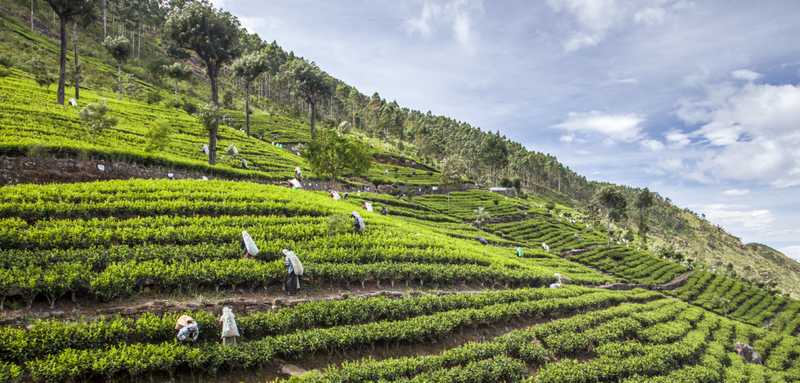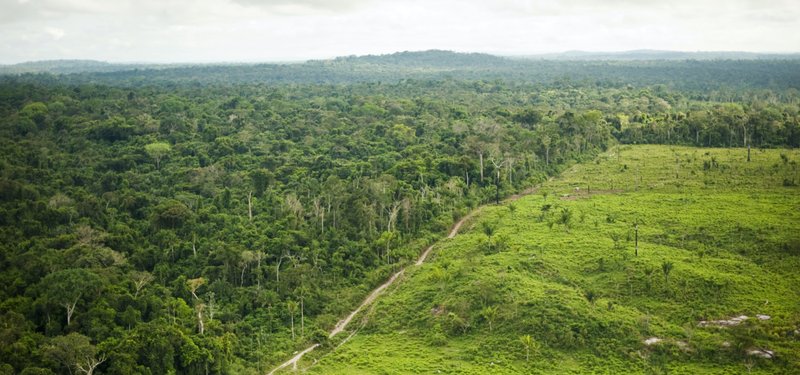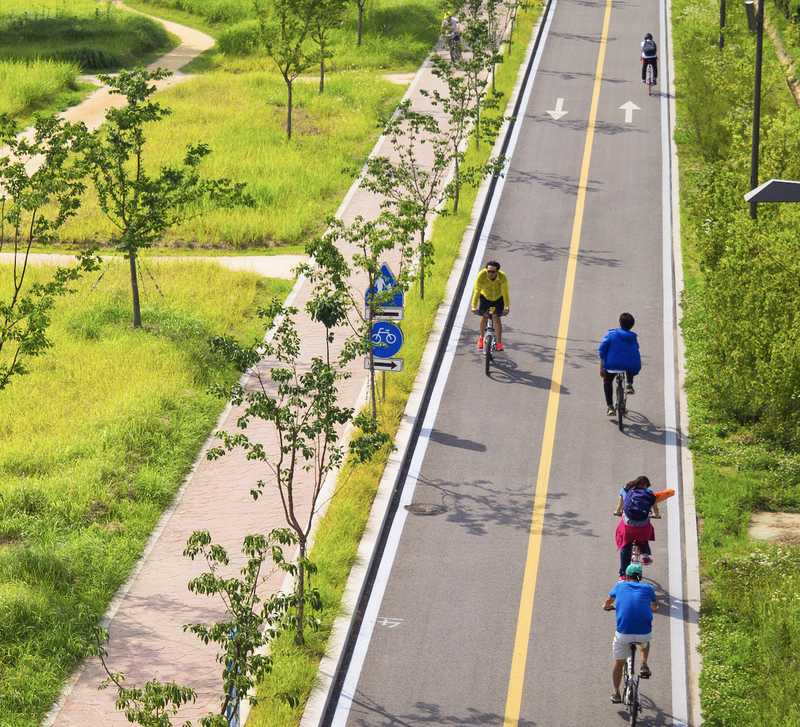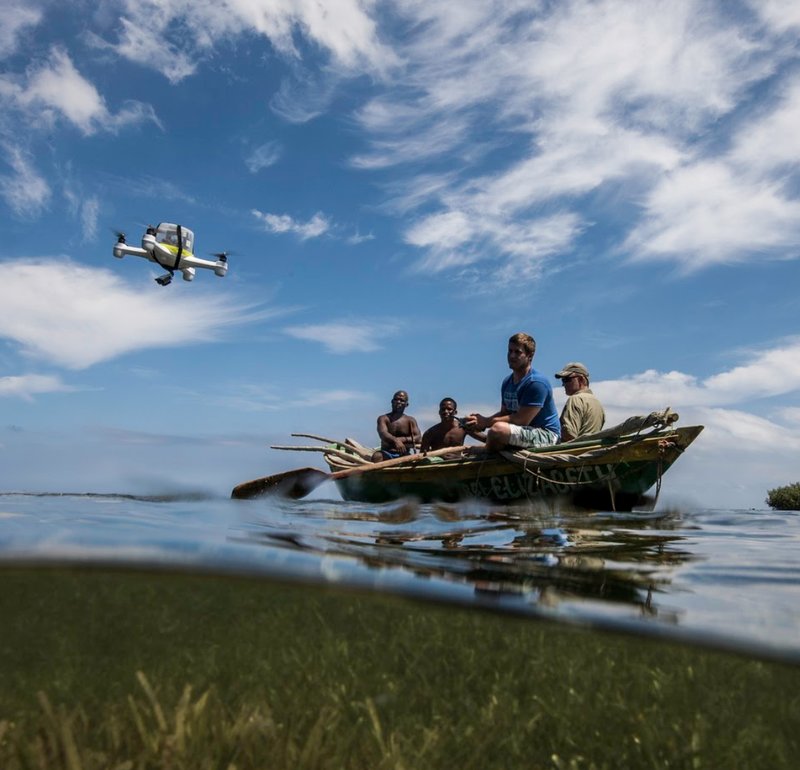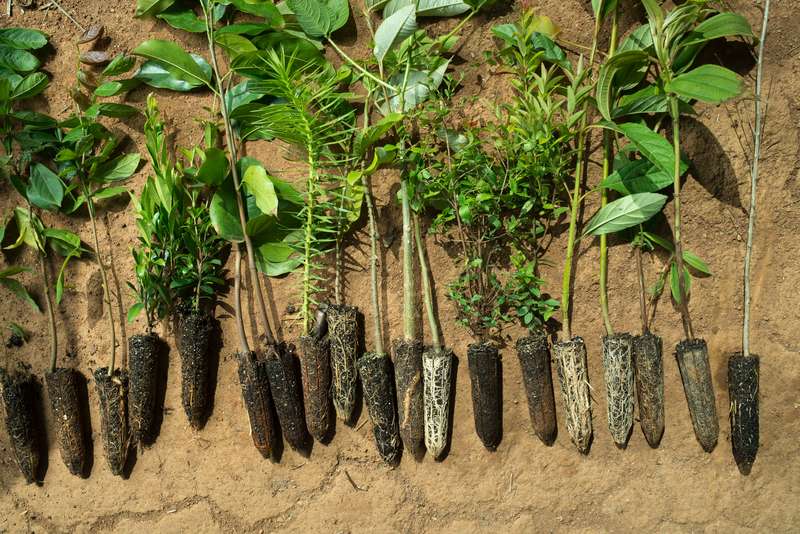
Restoration and management
We can protect restore and sustainably manage ecosystems while also growing our economy. As some national governments are already demonstrating in planning for a post-COVID world, investing in ecological restoration and management can create jobs and other economic benefits for the communities that need them most.
Headline statistics
- For every dollar spent on nature restoration, at least $9 of economic benefit can be expected.
- Initiating forest restoration of at least 350 million hectares by 2030, meanwhile, could generate $170 billion/year in net benefits from watershed protection, improved crop yields, and forest products as well as climate change mitigation benefits through the sequestration of more than 5 billion tons of CO2 each year.
- In the US alone, ecological restoration is a $9.5 billion industry employing 126,000 people, and indirectly generates $15 billion and 95,000 jobs.
- Restoring forests, peatlands, and mangroves globally has the potential to reduce global CO2e emissions by 10 billion tons annually with more than one-third included in carbon markets.
Value of restoration
- With one-third of the planet’s land degraded, a global effort to restore degraded lands either to natural forest or to productive use could generate major economic, employment, and climate gains.[1]
- Half of the world’s GDP is highly or moderately dependent on nature. The United Nations Environment Programme has found that for every dollar spent on nature restoration, at least $9 of economic benefits can be expected.[2]
- The opportunities for restoration are vast. Globally, up to 6 billion hectares of land are degraded (i.e. 20 times the size of France)[3] and some two billion hectares of the world’s landscapes offer opportunities for restoration.[4]
- Ecological restoration as a set of economic activities does not consistently fit within any single traditional economic sector (e.g. biomedical devices, automobile manufacturing), since pertinent activities range from scientific research and project planning, to earth moving and tree planting. By focusing the restoration economy around the industries that contribute to these efforts, a landmark 2015 report defined restoration as being comprised of the set of economic activities that contribute to restoration, from:
- project planning;
- engineering and legal services;
- suppliers of inputs;
- on-the-ground earthmoving forestry, and landscaping firms.[5]
- A 2017 report found that restoring the 160 million hectares of degraded land committed by over 40 countries under the Bonn Challenge could provide an estimated $84 billion in annual economic benefit worldwide.[6]
- Another 2017 study found that achieving the Bonn Challenge would generate a net benefit of between $0.7 and $9 trillion. The study found that €1 of investment in restoration yielded up to €27.38 in returns, depending on what social discount rate is applied today.[7]
- It is not commonly understood that without investments in large-scale ecosystem restoration, the negative effects of degradation are likely to greatly increase and compromise the well-being of present as well as future generations. Linked to this is a general under-appreciation of the benefits of investing in large-scale ecosystem restoration. Focusing solely on the economics, returns from ecosystem restoration are exceptionally high for society at large: approximately 50% for tropical forests, around 20% for other forests, about 42% for shrublands, and approximately 79% for grasslands over a 40-year time period.[8]
- US and British economists, including Joseph Stiglitz and Lord Nicholas Stern, argue that natural capital spending is fast-acting because worker training requirements are low, many projects have minimal planning and procurement requirements, and most facets of the work meet social distancing norms. Through their Nationally Determined Contributions (NDCs), many countries have already prepared “shovel-ready” projects, and in most lower-and middle-income countries (LMICs) these NDCs are heavily oriented towards infrastructure.[9]
- In the developing world, investments in restoration can create a variety of new income streams, including from the periodic sales of sustainably harvested wood (including for timber in buildings) and annual revenues from ecotourism. In 2014, research found that restoring 12% of degraded agricultural land could boost smallholders’ incomes by US$35-40 billion per year and feed 200 million people per year within 15 years. It can also increase resilience to weather shocks and reduce greenhouse gas emissions by nearly 2 Gt CO2e per year.[10]
Forest restoration
- Initiating forest restoration of at least 350 million hectares by 2030 could generate US$170 billion/year in net benefits from watershed protection, improved crop yields, and forest products as well as climate change mitigation benefits through the sequestration of more than 5 billion tons of CO2 each year.[11]
- An assessment of 19 countries that have made commitments under the Bonn Challenge – including Brazil, El Salvador, Mexico, Rwanda and the United States – has found that the benefits accruing from restoration activities include an additional 354,000 jobs, an average investment per hectare of at least US$235 and 1.379 billion tonnes CO2e sequestered.[12]
- Smarter ways of managing plantations and other working forests can improve their productivity, just as they can benefit the climate. Removing competing vegetation, more sensitive logging practices and longer cycles between harvests can promote tree growth. These and other enhanced natural forest management practices can be applied across the 1.9 billion hectares of production forest globally and annually remove 1.5 billion tons of CO2 from the atmosphere.[13]
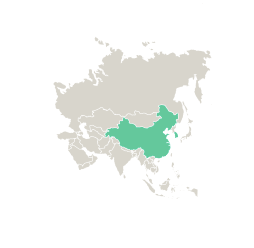
Asia
South Korea
Since the 1950s, South Korea’s forest cover has nearly doubled while its economy has grown more than 25-fold in real terms; in 2013, the Korean Forest Service estimated that Korea’s forests contributed 9% of GDP.[14]
China
In China, the Chinese Ministry of Water Resources and the World Bank worked together to produce two watershed rehabilitation projects spanning from 1994 to 2005, and between them mobilized US$298 million in Bank funds and US$193 million in Chinese government funding. The key elements of the projects were to halt the activities that led to degradation, in particular planting on steep slopes, tree-cutting, and free-range grazing of goats, and to actively encourage regeneration. The World Bank estimates that the projects lifted more than 2.5 million people out of poverty and boosted incomes from about US$70 to about US$200 per person per year through agricultural productivity gains and diversification.[15]

Europe
The Natura 2000 network has been estimated to support 104,000 direct jobs in protected areas management and conservation activities and 70,000 more indirect or induced jobs. This is based on annual investment of €6 billion for management and restoration of the network. In the future, it is expected that biodiversity needs could generate up to 500,000 jobs.[16]
The benefits of the EU Natura 2000 nature protection network are valued at between €200-300 billion per year.[17]
In June 2020, the Wildlife and Countryside Link announced that there are 330 ‘ready-to-go’ nature recovery projects across England that could generate some 10,000 jobs.[18]

North America
United States
In the US, as of 2015, more than 200,000 jobs were linked to the restoration sector.[19]
In the US, researchers have found that every $1 million invested in reforestation and sustainable forest management can support nearly 40 jobs[20], including foresters, botanists to grow saplings in nurseries, technicians to operate machinery, and laborers to transport and plant new trees. In 2014, the domestic ecological restoration sector directly employed approximately 126,000 workers and generated around $9.5 billion in economic output (sales) annually. This activity supported an additional 95,000 jobs and $15 billion in economic output through indirect (business-to-business) links and increased household spending.[21]
The same research found that $1 spent to restore forests in the US can deliver up to $30 in economic benefits. Restoration projects also tend to create localized employment benefits, while creating relatively well-paying jobs compared to average wages; similar to the construction industry at large. Forest restoration alone could reduce US emissions by nearly 300 million tons per year or 5% of its total GHG emissions.[22]
According to the Second Bonn Challenge Progress Report, a comprehensive assessment of the number of jobs generated through forest landscape restoration (FLR) activities made under the Bonn Challenge undertaken by the US Forest Service and its partners was not yet available. However, the restoration work associated with the 23 projects under the Collaborative Forest Landscape Restoration Program (comprising roughly 10% of USFS contributions to the Bonn Challenge) has supported an estimated 5,500 jobs per year since 2012. This was estimated to contribute a total of US$ 1.5 billion in local labour income.[23]
US National Oceanic and Atmospheric Administration (NOAA) funding for coastal habitat restoration supports on average 15 jobs per million dollars spent and up to 30 jobs per million dollars spent on labour intensive restoration projects.[24] This level of job creation is on a par or higher than for oil and gas or transportation infrastructure investments.[25] These investments yield follow-on socio-economic benefits to communities that exceed construction costs in terms of the protection of lives and property from storms and flooding, recreational and commercial fishing, tourism, and other coastal businesses.[26]
A 2013 study, which examined the economic impact of the expenditures from the American Recovery and Reinvestment Act (ARRA) of 2009 that the National Oceanic and Atmospheric Administration (NOAA) administered for coastal habitat restoration projects around the United States. It found that that the 50 ARRA projects administered by NOAA in the first year and half generated a total of 1409 jobs. These habitat restoration projects created, on average, 17 jobs per million dollars spent which is similar to other conservation industries such as parks and land conservation, and much higher than other traditional industries including coal, gas, and nuclear energy generation.[27]
Canada
In Canada, Forests Ontario calculated a 3:1 return on investment for the government’s annual investment in the 50 Million Tree Program and found that for every CAD$1.80 that Forests Ontario spends to support tree planting, no less than CAD$19.85 in ecosystem service value is derived. Ecosystem service value is derived from pollination and dispersal, recreation opportunities, aesthetic/amenity benefits and nutrient and waste regulation.[28]
Managing intact forests and natural areas for climate, biodiversity and cultural values is just as important as restoration. Indigenous peoples are the original stewards of the lands and waters and investing in Indigenous-led conservation and management can provide critical jobs to remote communities and support local, sustainable economic development.
An analysis of the Indigenous Guardian Watchmen programs on the British Columbia coast found a 10:1 return on investment annually for numerous social, cultural and economic Indigenous values. In the Great Bear Rainforest in BC, Coast Funds supports 27 First Nation stewardship programs and community economic development. In the last 10 years, Coast Funds has invested CAD$77 million and leveraged another CAD$190 million in new investments, which has produced 1,000 new jobs; and 100 new or expanded businesses. With only 18,000 people living in the region, the economic opportunity provided by Indigenous-led conservation and stewardship is enormous.[29]
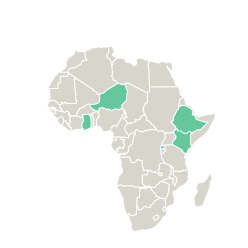
Africa
In Africa, the Green Wall of Africa initiative is a proven restoration benefiting communities from Senegal in the West to Djibouti in the East. Since the birth of the initiative in 2007, life has started coming back to the land, bringing improved food security, jobs and stability to people’s lives. According to the UN Commission to Combat Desertification, the ultimate goal is to complete the wall by 2030 and bring with it 50 million hectares of restored land, food security for 20 million people, access to climate change-resilient agricultural technologies for 10 million small farms and 350,000 jobs across the continent.
Ethiopia
In Ethiopia, the Humbo Assisted Natural Regeneration Project increased local incomes and helped restore 2,700 hectares of biodiverse native forest, boosting carbon sequestration benefits. More tree cover also reduced local drought vulnerability.[30]
Niger
In Niger, the Maradi and Zinder regions have interplanted nitrogen-fixing trees on cropland, or allowed roots and stumps to regenerate, increasing tree and shrub cover 10- to 20-fold. The strategy has significantly increased agricultural productivity on 5 million hectares of farmland and helped restore at least 250,000 hectares of severely degraded land that had been of little use for agriculture or forestry. At least one-quarter of producers in the area adopted improved natural resource management techniques. Biodiversity was increased and soil fertility improved measurably in the entire area. Gross real annual income in the region has grown by $1,000 per household for over one million households, more than doubling real farm incomes and stimulating local non-farm services.[31]
Rwanda
In Rwanda, a report from the Rwanda Water and Forestry Authority (RWFA) monitoring and evaluation officers for the year 2017–2018 identified 22,325 jobs created in the forestry sector. The data reported here cover total jobs within the forestry sector pertaining to forest landscape restoration (FLR) activity made under the Bonn Challenge but do not include employment statistics from different sectors that could also involve FLR interventions. Rwanda’s Green Fund, FONERWA, indicated that 137,562 green jobs were created in 2013–2018 under 36 of the 44 Barometer projects evaluated.[32]
Ghana
In Ghana, multiple programmes under the Bonn Challenge, such as Ghana’s Labour for Youth in Afforestation module, have created close to 90,000 jobs.[33]
Kenya
Komaza in coastal Kenya is a company enabling small-scale farmers to participate in industrial wood markets. It partners with rural farmers to plant woodlots that are collectively managed as ‘virtual plantations’. Komaza’s model offers a new income stream to smallholder farmers, while reducing pressure on virgin forest and increasing the area of reforested land. To date, Komaza has 4,000 hectares planted with 14,000 farmers ‒ with aims to scale to 30,000 hectares.[34]
Malawi
The government spends 1.5% of its annual budget to mobilize Malawi’s youth to protect and plant trees across 50,000 hectares. In the first 18 months of the program, 11,283 youth from 472 youth groups have been employed.[35]
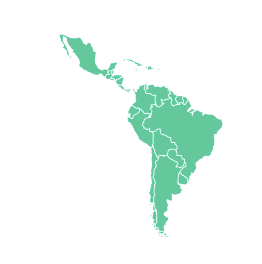
Latin America and the Caribbean
WRI found that bringing life back to degraded lands in Latin America and the Caribbean would yield $23 billion in net benefits over 50 years. Its analysis shows that on average, farmers who restore their land can earn an extra $1,140 per hectare in net economic value from restoration.[36]
Costa Rica
Between 1986 and 2005, Costa Rica’s forest cover increased nearly 20% while its economy grew 2.5-fold in real terms.[37]
Brazil
For 2018, prior to current setbacks, the government of Brazil reported an area of 9,424,802 hectares under natural regeneration in the Amazon as progress towards achieving its Bonn Challenge target. Restoration interventions are mainly natural regeneration, but also planted forest and woodlots, watershed protection and agroforestry. The benefits associated with restoration efforts across the country include on average 151,000 jobs generated per year and total carbon sequestration of 1.2 billion tonnes of CO2 (tCO2).[38]
El Salvador
In El Salvador, approximately 12,235 full-time equivalent (FTE) short-term jobs were provided by implementation of national and sub-national forest landscape restoration pledges made under the Bonn Challenge, while the management of the restored landscape created 2,715 FTE long-term jobs. The main findings can be summarised as follows: 1) Sustainable forest management practices, specifically fire prevention, have been implemented the most (29% of the total area), creating the majority of FTE short-term jobs. 2) Long-term jobs were mostly supplied through conservation agriculture and the agroforestry system with staple grains. This is due to the high labour needs for land management associated with these two techniques, while forest fire management is typically less labour intensive.[39]
Mexico
In Quintana Roo State, Mexico, analysis estimates the creation of jobs as 0.1–0.37 job per hectare, depending on the forest landscape restoration (FLR) activity made under the Bonn Challenge. ROAM analysis for Quintana Roo indicates that a total of 22,480 jobs directly related to FLR activities may have been created from 2011–2017. This number is based on estimates of labour required to carry out specific technological packages related to each restoration category implemented.[40]

Oceania
Australia
According to analysis done by TNC in Australia, an investment of $100 million will rebuild shellfish reefs in 60 locations, and create 850 jobs in maritime construction, aquaculture, fisheries and tourism service sectors.[41]
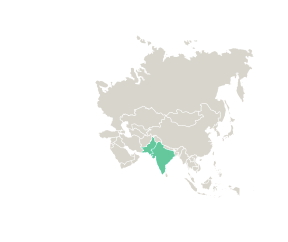
Asia
Pakistan
During the COVID-19 crisis, millions of labourers have been made unemployed leading the government to announce a scheme to redeploy them in reforestation work as part of the country’s 10 Billion Tree Tsunami program, creating an estimated 63,000 jobs.
India
The Indian Government has directed a higher percentage of central tax revenue to states based on their efforts to protect or increase forest cover. In simple terms, with its the decision to increase the “weightage” given to forest cover – from 7.5% to 10%. In its formula for tax devolution, the government is hoping to mobilize additional billions of dollars in recognition of the central role forests play in the country’s sustainable development, tackling climate and supporting livelihoods.[42]
Resources
[1] The Global Commission on the Economy and Climate, Unlocking the Inclusive Growth of the 21st Century (2018)
[2] UNEP, FAO, Strategy of the UN Decade on Ecosystem Restoration (2020)
[3] OECD, Biodiversity: Finance and the Economic and Business Case for Action, report prepared for the G7 Environment Ministers’ Meeting (2019)
[4] The Global Commission on the Economy and Climate, Unlocking the Inclusive Growth of the 21st Century (2018)
[5] Bendor et al, Estimating the Size and Impact of the Ecological Restoration Economy (2015)
[6] WRI, How Can Restoring Degraded Landscapes Deliver Financial Returns? (2017)
[7] Verdone & Seidl, Time, space, place, and the Bonn Challenge global forest restoration target (2017)
[8] UNEP, FAO, Strategy of the UN Decade on Ecosystem Restoration (2020)
[9] Hepburn et al, Will COVID-19 fiscal recovery packages accelerate or retard progress on climate change? (2020)
[10] The Global Commission on the Economy and Climate, The New Climate Economy: Better Growth Better Climate(2014)
[11] The Global Commission on the Economy and Climate, The New Climate Economy: Better Growth Better Climate(2014
[12] IUCN, Second Bonn Challenge progress report (2019
[13] The Nature Conservancy, Lands of Opportunity (2017)
[14] The Global Commission on the Economy and Climate, The New Climate Economy: Better Growth Better Climate(2014
[15] The Global Commission on the Economy and Climate, The New Climate Economy: Better Growth Better Climate(2014
[16] Institute for European Environmental Policy, Natura 2000 & Jobs (2017)
[17] Institute for European Environmental Policy, Natura 2000 & Jobs (2017)
[18] Wildlife and Countryside (2020)
[19] Bendor et al, Estimating the Size and Impact of the Ecological Restoration Economy (2015)
[20] Bendor et al, Estimating the Size and Impact of the Ecological Restoration Economy (2015)
[21] Bendor et al, Estimating the Size and Impact of the Ecological Restoration Economy (2015)
[22] Fargione et al, Natural climate solutions for the United States (2018)
[23] Second Bonn Challenge progress report (2018)
[24] Samonte et al, Socioeconomic Benefits of Habitat Restoration (2017)
[25] Perera, Rebuilding our economy, restoring our environment (2012)
[26] ABT Associates, Estimating the Change in Ecosystem Service Values from Coastal Restoration (2014)
[27] Edwards et al, Investing in Nature: Restoring Coastal Habitat Blue Infrastructure and Green Job Creation (2013)
[28] Forests Ontario, The Economic Value of Tree Planting in Southern Ontario (2019)
[29] Valuing Coastal Guardian Watchmen Programs: A Business Case (2016)
[30] World Bank, Ethiopia: Humbo Assisted Natural Regeneration Project
[31] The Global Commission on the Economy and Climate, The New Climate Economy: Better Growth Better Climate(2014
[32] Second Bonn Challenge progress report (2018) The report notes “Finally, additional efforts to clarify FLR-linked jobs in sectors other than forestry are also required for a more complete picture of the economic impacts of FLR interventions.”
[33] Second Bonn Challenge progress report (2018)
[34] The Global Commission on the Economy and Climate, Unlocking the Inclusive Growth of the 21st Century (2018)
[35] Reytar et al, Malawi is Putting its Money Where its Forests Are (2018)
[36] Vergara, et al, The Economic Case for Landscape Restoration in Latin America (2016)
[37] The Global Commission on the Economy and Climate, The New Climate Economy: Better Growth Better Climate(2014
[38] Second Bonn Challenge progress report (2018) — The estimate for socio-economic impacts achieved through the creation of jobs was calculated using a model to estimate the number of jobs generated through achieving the target of the National Policy for the Recovery of Native Vegetation (PROVEG).11 The creation of a total of 112,000–191,000 jobs per year is projected. This data considers the number of people directly involved in the implementation and maintenance of the restored areas in the adopted scenarios for each model considered (natural succession, enrichment and total planting). It also includes indirect jobs in the related production chains of timber and non-timber products from restored areas.
[39] Second Bonn Challenge progress report (2018)
[40] Second Bonn Challenge progress report (2018)
[41] Select the location of next SA shellfish reef (2020)
[42] Busch et al, Did India’s ecological fiscal transfers incentivize state governments to increase their forestry budgets?(2020)
